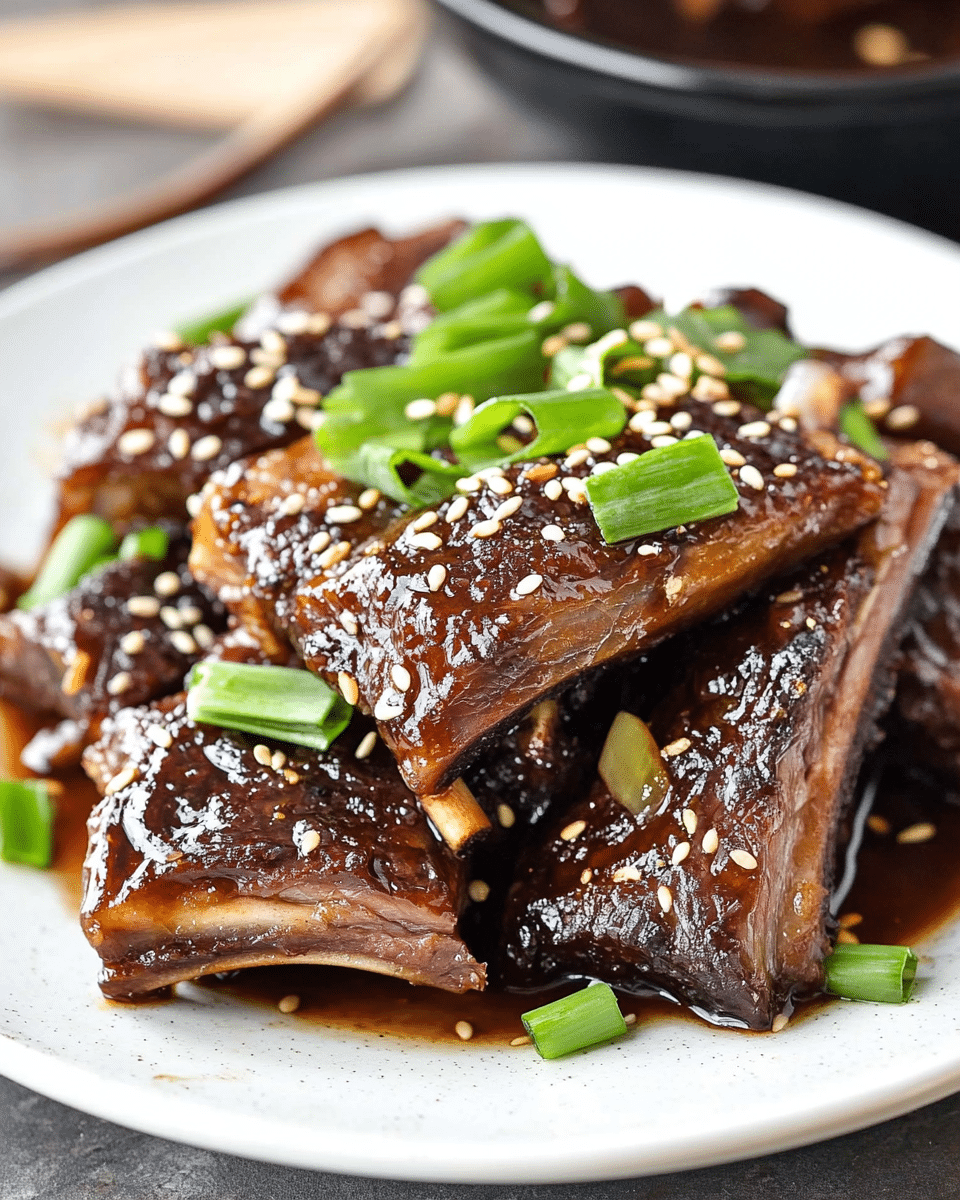The rich aroma of Korean spices fills the kitchen as these Slow Cooker Korean Beef Short Ribs simmer to perfection. Infused with a soy-garlic marinade, these kalbi-style ribs transform into ultra-tender bites that practically fall off the bone. The addition of grated pear or apple brings a subtle sweetness, balancing the umami depth of the marinade. Perfect for family dinners or a cozy night in, this dish is a delightful way to enjoy authentic Korean flavors with minimal effort. Just prep your ingredients, let the slow cooker do its thing, and come back to a savory, crowd-pleasing meal. Garnish with sesame seeds and green onions for a burst of freshness and crunch.
Full Recipe:
Ingredients:
-
3–4 pounds bone-in beef short ribs
-
1/2 cup soy sauce
-
1/4 cup brown sugar
-
2 tablespoons rice vinegar
-
2 tablespoons sesame oil
-
1 tablespoon freshly grated ginger
-
4 cloves garlic, minced
-
1/2 cup pear or apple, grated
-
1/2 teaspoon crushed red pepper flakes (optional)
-
1/2 cup beef broth
-
1 tablespoon cornstarch + 2 tablespoons water (for thickening, optional)
-
Sliced green onions and sesame seeds, for garnish
Directions:
-
Place short ribs in the slow cooker.
-
In a bowl, whisk together soy sauce, brown sugar, rice vinegar, sesame oil, ginger, garlic, pear (or apple), and red pepper flakes.
-
Pour the marinade over the ribs, making sure they’re well-coated.
-
Add beef broth to the slow cooker.
-
Cover and cook on low for 8–9 hours or on high for 4–5 hours, until ribs are tender.
-
Optional: Remove ribs and skim fat from liquid. Transfer liquid to a saucepan, bring to a simmer, and stir in cornstarch slurry to thicken the sauce.
-
Serve ribs with sauce spooned over the top and garnish with green onions and sesame seeds.
Prep Time: 15 minutes | Cooking Time: 8 hours | Total Time: 8 hours 15 minutes
Kcal: 450 kcal | Servings: 6 servings
Discover the Irresistible Flavor of Slow Cooker Korean Beef Short Ribs
Slow Cooker Korean Beef Short Ribs, also known as Kalbi or Galbi Jjim, are a beloved staple of Korean cuisine that offer the perfect balance of savory, sweet, and umami flavors. This dish is traditionally made with bone-in beef short ribs marinated in a flavorful blend of soy sauce, garlic, ginger, sesame oil, and a touch of sweetness from brown sugar and fruit such as pear or apple. What sets this version apart is the use of a slow cooker, which transforms this dish into a hassle-free, yet incredibly satisfying culinary experience.
Not only is this recipe perfect for weeknight dinners or weekend feasts, but it also showcases how deeply flavorful and tender beef can become when cooked low and slow. Whether you’re new to Korean cuisine or a seasoned enthusiast, this dish brings authentic taste right to your table with minimal prep and maximum reward.
The Cultural Roots of Kalbi
Kalbi (or Galbi) is a Korean term that translates to “rib,” typically referring to beef short ribs in culinary contexts. In Korean households, Kalbi is often prepared for special occasions and holidays. Traditionally, the ribs are marinated and grilled over an open flame or pan-fried. However, braising and slow cooking have become popular methods in modern kitchens due to the incredibly tender results they produce.
The inclusion of fruits like pear or apple in the marinade is a nod to the Korean technique of natural meat tenderizing, and it adds a light, aromatic sweetness that’s signature to the dish. These techniques are deeply embedded in Korean cooking and reflect the cuisine’s balance of flavor, texture, and presentation.
Why Use a Slow Cooker?
Using a slow cooker for Korean beef short ribs allows you to achieve melt-in-your-mouth tenderness with very little active cooking time. This method is perfect for busy families or individuals who want to enjoy a gourmet-style dinner without spending hours over the stove. The slow and steady heat breaks down the collagen in the meat, rendering it silky and succulent.
Moreover, slow cooking locks in the flavors of the marinade and ensures that every bite is deeply infused with the essence of garlic, soy, sesame, and sweetness. Once everything is in the pot, all you need to do is wait your kitchen will be filled with irresistible aromas as the day goes on.
The Flavor Profile: Sweet, Savory, and Irresistible
The hallmark of Korean short ribs lies in its distinct and layered flavor profile. The soy sauce base provides a deep umami richness, while sesame oil brings a toasty nuttiness that is quintessentially Korean. Garlic and ginger give it a pungent, warming bite, and brown sugar adds depth and caramelization to the glaze that develops during cooking.
A unique addition to many Korean marinades is grated pear or apple. These fruits not only enhance the flavor but also act as natural tenderizers. Combined with beef broth, these ingredients form a sauce that’s both luxurious and comforting perfect over a bed of steamed rice or paired with a side of kimchi for a traditional Korean touch.
Perfect Pairings and Serving Suggestions
While these short ribs can easily stand alone as the main attraction, pairing them with traditional Korean sides elevates the entire meal. Here are a few ideas:
-
Steamed White Rice or Sticky Rice: A neutral base that soaks up the rich sauce beautifully.
-
Kimchi: The fermented tang of kimchi cuts through the richness of the meat and offers a palate-cleansing contrast.
-
Pickled Vegetables (Banchan): Lightly pickled cucumbers or radishes offer a crunchy, refreshing bite.
-
Sautéed Spinach or Korean-style greens: These add a healthful, earthy balance to the hearty meat.
For a more Western-inspired presentation, you can even serve the short ribs with creamy mashed potatoes or roasted vegetables for a fusion twist.
Hosting and Meal Prep Tips
This dish is ideal for entertaining, as the slow cooker does most of the work. You can prepare the marinade a day ahead, allowing the ribs to soak up the flavor overnight in the refrigerator before starting the slow cooker the next morning. This not only deepens the flavor but also frees up your time on the day of your event.
The leftovers are just as delicious, if not better. The flavors continue to develop overnight, making this a fantastic make-ahead meal for lunches or next-day dinners. Simply store in an airtight container and refrigerate for up to 4 days. It also freezes well for longer storage.
Adaptability and Substitutions
This recipe is incredibly flexible. Here are some suggestions to make it your own:
-
Protein Alternatives: Try it with pork ribs or boneless beef chuck roast for variation.
-
Fruit Variations: If you don’t have Asian pear, use a Fuji or Gala apple.
-
Spice Level: Add more crushed red pepper flakes or a spoonful of gochujang (Korean chili paste) for heat.
-
Gluten-Free Option: Use tamari or coconut aminos in place of soy sauce.
This adaptability means you can easily tweak the recipe based on dietary needs or what’s already in your pantry.
Why This Dish Works
The true magic of Slow Cooker Korean Beef Short Ribs lies in its simplicity and depth of flavor. It’s a dish that showcases the importance of patience in cooking, rewarding you with succulent meat and a sauce so flavorful, you’ll want to drizzle it over everything.
From busy weeknights to celebratory weekends, it offers both convenience and indulgence. The recipe also encourages culinary exploration opening doors to Korean cooking techniques and ingredients that can be applied to other dishes in your kitchen.
Conclusion:
Whether you’re new to Korean food or a longtime fan, Slow Cooker Korean Beef Short Ribs are a showstopping dish that combines ease of preparation with gourmet-level flavor. The slow cooker method takes all the stress out of dinner prep while producing consistently tender and flavorful results.
With a delicious blend of savory, sweet, and aromatic ingredients, this dish is a crowd-pleaser that’s perfect for everything from family dinners to special gatherings. Serve it with your favorite Korean sides or adapt it to your taste no matter how you enjoy it, this recipe is sure to earn a permanent spot in your culinary rotation.






